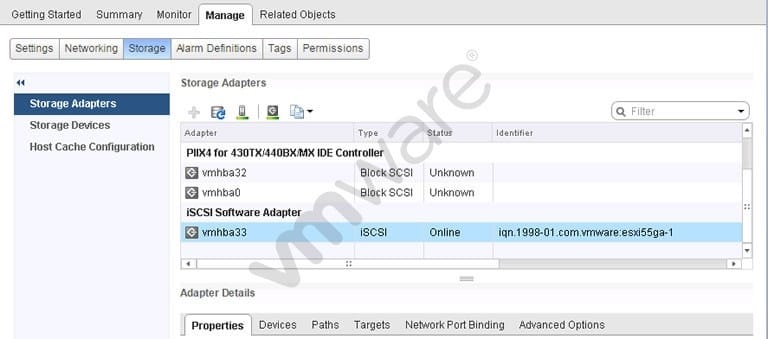Exam Details
Exam Code
:2V0-621DExam Name
:VMware Certified Professional 6 – Data Center Virtualization Delta BetaCertification
:VCP6-DCVVendor
:VMwareTotal Questions
:245 Q&AsLast Updated
:May 06, 2025
VMware VCP6-DCV 2V0-621D Questions & Answers
-
Question 171:
Refer to the Exhibit.

An administrator is attempting to enable Enhanced vMotion Compatibility (EVC), but receives the error shown in the Exhibit. Which condition would explain the error?
A. The ESXi hosts are not licensed for EVC.
B. The administrator does not have privileges to enable EVC.
C. The ESXi host CPU has the Intel No-Execute feature disabled.
D. The administrator has turned on Intel Virtualization Technology.
-
Question 172:
Refer to the Exhibit.

An administrator is configuring a storage device as shown in the Exhibit.
What is the expected effect on the stated device after running the command?
A. I/O will rotate on all storage targets regardless of port group state.
B. I/O will rotate on all storage targets that are Active Optimized state only.
C. I/O will rotate on all storage targets that are Active Unoptimized state only.
D. I/O will rotate on all storage targets that are on Available Nodes only.
-
Question 173:
An administrator needs to recover disk space on a previously-used thin provisioned virtual disk. The volumes where the administrator needs to recover the disk blocks are on VAAI- compliant storage arrays. Which two actions should the administrator take accomplish this task? (Choose two.)
A. Perform a Storage vMotion to another volume in order to force free space recovery to occur. This recreates the volume in a new location and recovers all unused space.
B. Use VMware Converter to migrate the virtual machine to a new datastore. This will recreate the volumes and recover all unused space.
C. Issue the vmkfstools -vmfs unmap command within the VMFS volume directory on the ESXi host console.
D. Execute the esxcli storage vmfs unmap command.
-
Question 174:
Refer to the Exhibit.

An administrator would like to add Challenge Handshake Authentication Protocol (CHAP) to an iSCSI adapter. The administrator accesses the Storage Adapters menu as shown in the Exhibit. In which tab can the task be accomplished?
A. Properties
B. Advanced Options
C. Targets
D. Devices
-
Question 175:
Where is a Virtual SAN Fault Domain configured?
A. VMware Virtual SAN Cluster configuration
B. VMware High Availability Cluster configuration
C. Distributed Resource Scheduler configuration
D. Datacenter Advanced Settings configuration
-
Question 176:
Which two statements are true regarding Virtual SAN Fault Domains? (Choose two.)
A. They enable Virtual SAN to tolerate the failure of an entire physical rack.
B. Virtual SAN ensures that no two replicas are provisioned on the same domain.
C. Virtual SAN ensures that all replicas are provisioned on the same domain.
D. They require VMware High Availability (HA) to ensure component distribution across domains.
-
Question 177:
An administrator is configuring virtual machines to use Worldwide Port Names (WWPNs) to access the storage. Which two conditions are required? (Choose two.)
A. The switches in the fabric must be N-Port ID Virtualization aware.
B. The virtual machines must be using passthrough Raw Disk Mapping (RDMp).
C. The virtual machines must be using Virtual Machine Disk (VMDK).
D. The switches in the fabric must be Storage I/O Control aware.
-
Question 178:
An administrator created a six node Virtual SAN cluster, created a fault domain, and moved three of the six nodes into that domain.
A node that is a member of the fault domain fails.
What is the expected result?
A. The remaining two fault domain members are treated as failed.
B. The remaining two fault domain members stay protected by the domain.
C. One of the non-member nodes will be automatically added to the fault domain.
D. VMware High Availability will restart virtual machines on remaining nodes in the domain.
-
Question 179:
Which two solutions require Physical Mode Raw Device Mapping (RDM)? (Choose two.)
A. Direct access to the storage array device
B. Virtual Machine Snapshots
C. Hardware Acceleration
D. Guest Clustering across ESXi hosts
-
Question 180:
A device's vStorage API for Array Integration (VAAI) support status command line output shows:
naa.500253825002a865 VAAI Plugin Name: ATS Status: unsupported Clone Status:
unsupported Zero Status: supported Delete Status: unsupported
What is the corresponding VAAI support status in the vSphere Web Client?
A. Unknown
B. Supported
C. Not supported
D. Unsupported
Related Exams:
Tips on How to Prepare for the Exams
Nowadays, the certification exams become more and more important and required by more and more enterprises when applying for a job. But how to prepare for the exam effectively? How to prepare for the exam in a short time with less efforts? How to get a ideal result and how to find the most reliable resources? Here on Vcedump.com, you will find all the answers. Vcedump.com provide not only VMware exam questions, answers and explanations but also complete assistance on your exam preparation and certification application. If you are confused on your 2V0-621D exam preparations and VMware certification application, do not hesitate to visit our Vcedump.com to find your solutions here.